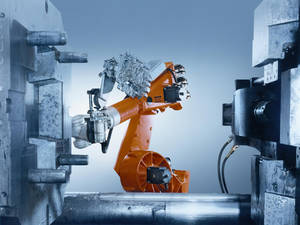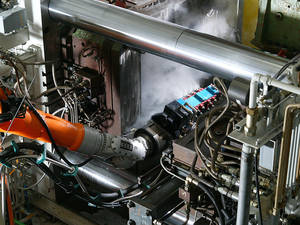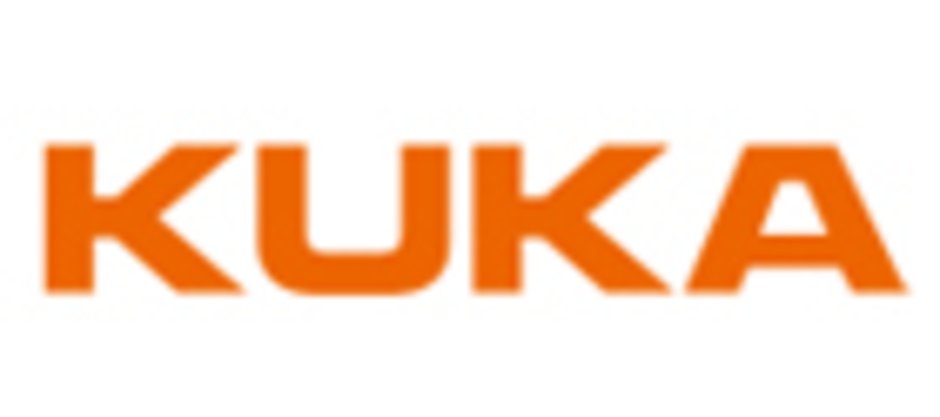Foundry-Planet spoke to Key Technology Manager Cajus Baierl, Key Technology Manager at KUKA Roboter GmbH, Augsburg, about opportunities, trends and possible applications for robotic automation in foundry industry.
Mr Baierl, automation measures are often accompanied by fear of job losses. How justified is this fear within the foundry industry?
Not at all. Quite the opposite, in fact! Foundry environments are often hot and dirty. It is hard to find qualified personnel. Equipped with special protective packages, robots effortlessly withstand heat, humidity, sand and cleaning agents. This makes them the ideal alternative, particularly for tough tasks that are arduous for human workers. Far from jeopardizing jobs, industrial robots actually secure them – and also ensure a decisive quality advantage.
 |
| Cajus Baierl - Key Technology Manager at KUKA Roboter GmbH |
Are there any robotic concepts at all that are suitable for foundry applications?
Robots are ideally suited to applications in forges and foundries. This applies particularly to the easy-to-use KUKA robots, which allow close cooperation with the human operator and can be handled with a minimum of training. No matter what the application, be it machine or press tending or the machining of heavy and complex workpieces, the KUKA.SmartGUI user interface significantly reduces the training and programming requirements still further. New programs can be created and existing ones optimized even during ongoing production. The KR C2 robot controller allows the simultaneous operation of several axes. KUKA Motion Control can be used to operate even complex non-KUKA kinematic systems – at relatively low cost. This all adds up to robotic concepts that significantly improve process reliability as well as the working environment for employees in the foundries.
What kind of special appurtenance does KUKA Robotics offer the foundry industry?
Special protective packages, such as “KUKA ProtectionPlus” guard the robot additionally against heat, humidity, sand and cleaning agents, thus ensuring high process stability and availability, even in the rough environment of foundries and forging shops. This in turn contributes systematically to high quality of the products being manufactured. Harsh conditions are not going to wear the robots out.
6-axis robots are generally used here for loading and unloading of machines, or for linking together peripheral plant such as trimming presses, cooling basins and conveyors. In the field of die casting or when automating forging presses, the number of spraying robots is increasing markedly; they are used for the application of release agents. This is attributable above all to the high flexibility, relatively low costs of acquisition, long maintenance intervals, high availability and reproducibility of KUKA robots.
Are foundries keeping up with the times as far as robots are concerned?
 |  |
What other foundry applications still have untapped potential?
Many permanent mold casting systems, both old and new, can still be effectively automated. Six-axis KUKA robots open up intelligent new system concepts which were not previously possible. Companies can combine individual systems to form a group, for example, or automate individual systems. This enables the simultaneous manufacture of different products. There is also still enormous potential for automation with industrial robots in sand casting: the large variety of parts, small batch sizes and different production cycles previously hindered large-scale automation. Applications developed jointly with our partners, offering simple, user-friendly programming, will increase the degree of automation in this field in the medium term. Robots also bring clear competitive advantages with regard to finishing work: after being led once over the castings, the manually-guided robots save the path thus taught. Such human-machine cooperation is set to increase in all areas in the future. The degree of automation also depends, of course, on the geographical location; there is significantly more automation in western Europe than in Asia.
How significant are cooperation models for human-machine interaction?
Where a wide range of different products are manufactured, robots were long inferior to human operators in terms of experience and flexibility. Lack of know-how also made it difficult to program robot movements and influencing variables. With small batch sizes, this was simply not worth the effort. The process is now more widely understood – and increasingly being adopted! The reason for this lies in the many advantages once the solution has been found: a robot works untiringly and precisely – even under circumstances which would constitute a health hazard for human workers. Robots also ensure consistently high quality and a low reject rate. Uniting the strengths of humans and robots in a team gives you a decisive edge.
Contact to <link _top>KUKA AG in our Suppliers Profile


